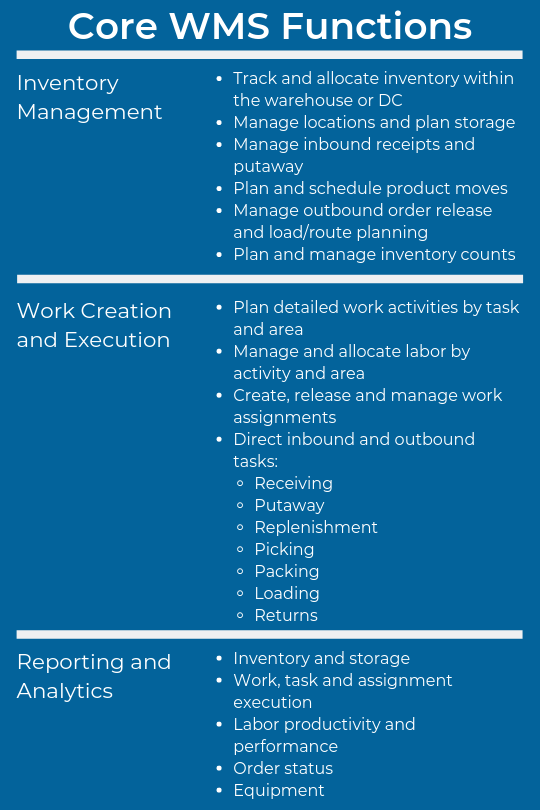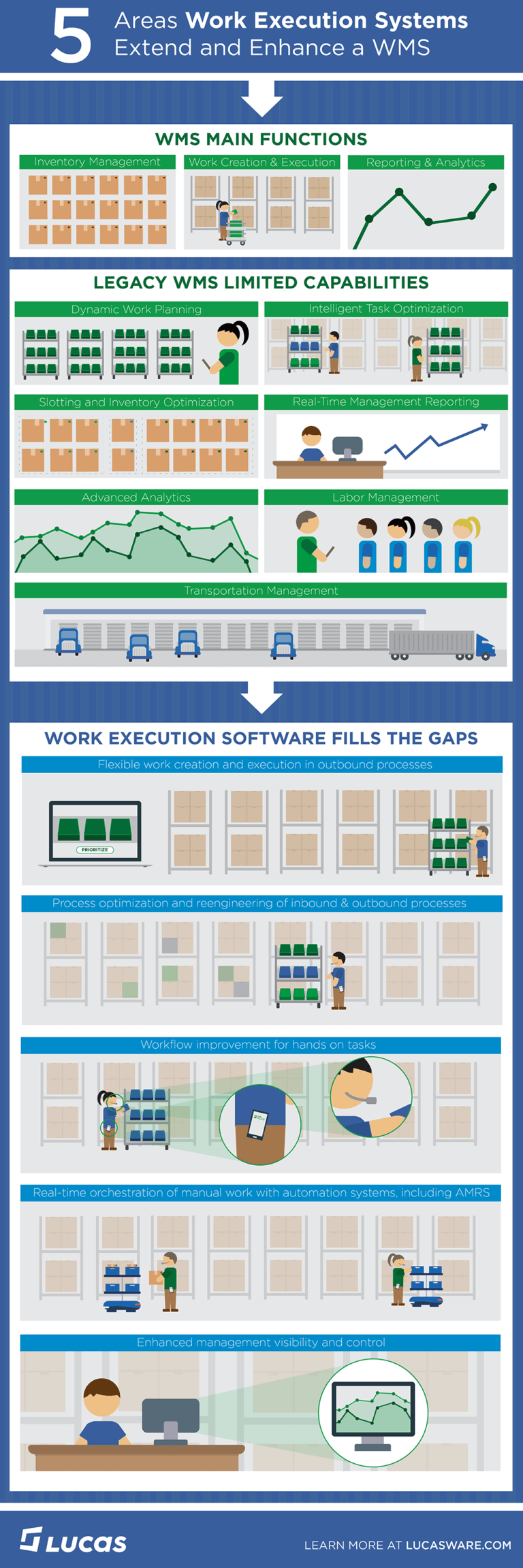Buying a new warehouse management system to replace an existing ERP, host, or legacy WMS is not always the best way to improve warehouse operations. The example of Baptist Health South Florida shows why.
The operations team at Baptist Health South Florida faced a dilemma. The inventory management system provided by their ERP was more than adequate, but they needed better warehouse management tools to improve efficiency, accuracy and customer service. First they considered buying a new warehouse management system (WMS). Instead they opted to install a warehouse optimization solution to optimize and extend their PeopleSoft ERP.
Baptist Health’s experience is emblematic of a wider trend in the warehouse and distribution center space. The prevalence of older inventory management systems is spurring investments in new WMS software. But for many companies, the best way to overcome the shortcomings of a legacy warehouse management system may not be to buy a new WMS.
The Legacy Warehouse Management System Challenge
Every company operating a warehouse or distribution center today is challenged to fill orders more quickly, accurately, and efficiently. They are also dealing with more varied – and changeable – customer requirements. In response, companies are investing in a range of technology solutions, and many are rushing to replace older host, ERP or warehouse management systems.
Warehouse management system software was first introduced in the 1990s. WMS was originally an add-on or customized extension to an ERP system. Today WMS is a mature software product category, so it’s no surprise that a large percentage of DCs are using WMS systems that are more than five years old. In addition, many DCs rely on the warehouse management functionality of their ERP systems, route accounting software (RAS), or on custom-built inventory systems. In a 2018 survey of DC executives, Peerless Research Group found that 78% of warehouses and DCs are using basic WMS systems (including in-house systems) or ERP WM modules.
Replacing outdated technology makes sense, but age alone isn’t the most important factor to consider. The key issue for any company looking at WMS options is to define the capabilities you are lacking today, and then to determine the best way to fill those functional gaps.
Basic and Advanced Functions of a Warehouse Management System
Warehouse management functionality can be divided into three general categories: Inventory control, work execution, and reporting. Naturally, different systems offer different levels of capability. For example, many ERP and RAS systems provide basic inventory tracking capabilities (how much inventory of a given product is in the warehouse). But many to not include detailed tracking to the bin level (what quantity of product is in each location – forward pick location versus overstock, etc.). Bin level tracking is common in most standalone WMS packages, and more sophisticated ERP inventory systems.
Just as WMS itself was once an add-on to an ERP, today it is common for DCs to purchase add-on systems to supplement the basic warehouse and inventory capabilities of their current system. For example, many companies add standalone labor management systems to get richer productivity tracking, workforce planning and labor standards tools. Other common solutions for supplementing core WMS functionality are transportation management and slotting software. Some WMS vendors offer LMS, TMS and slotting as add-on modules to their WMS product. There are also a number of specialist software providers that offer best-of-breed systems.
Along these same lines, it is increasingly common for DCs to supplement their WMS with external work execution systems. For automated execution, DCs typically use a Warehouse Control System (WCS) to manage their automation systems, and more and more are adding Work Execution or Warehouse Execution Systems to fully optimize, direct, and coordinate the movement of products by people and machines (including autonomous mobile robots, so called AMRs).
Now, let’s look at the situation at Baptist Health South Florida.
Warehouse Optimization at Baptist Health South Florida
As noted above, the operations team at Baptist Health South Florida was happy with their ERP inventory management system, in part because it provided a single record of inventory across the DC and the organization’s hospital network. What they needed, however, was more advanced picking and other work execution tools for the warehouse.
In Baptist’s case, the Lucas solution supplements their ERP with more flexible, adaptable workflows, and richer reporting and analytics. In addition, the Lucas software had a far lower initial cost and faster implementation time, as well as a larger return on investment. Dale Adamson, AVP of Logistics and Distribution, summed it up best: “We got 70% of what we wanted in a new WMS, but at 1/8 of the cost.”
Beyond the cost considerations, the Lucas solution includes travel optimization tools and next generation mobile applications that are not available in a WMS. With the Lucas solution in place, Baptist Health doubled productivity in their main piece picking area, and increased productivity and accuracy across all areas of the DC. (For the full story on Baptist Health South Florida, read the case study.)
5 Areas Warehouse Optimization Solutions Enhance A WMS
As a newer product category, it’s worth explaining the core capabilities of warehouse optimization solutions. First, these solutions can rely on the inventory and order management capabilities of a WMS, host or ERP without change. Using order and inventory information from other systems, warehouse optimization solutions improve warehouse and DC operations in five areas:
1. Flexible work creation and execution in outbound processes:
a. Break free from strict wave-based picking.
b. Create variable pick processes for different order types and/or profiles.
c. Dynamically prioritize and optimize work assignments (batches, for example).
2. Process optimization and reengineering of inbound and outbound processes, including:
a. Zone picking
b. Batch picking
c. Two-stage picking
d. Real-time replenishment and short filling
e. Task interleaving
f. Travel/pick path optimization
3. Workflow Improvement for hands-on-tasks:
a. Efficient, consistent system-directed processes (replace paper)
b. Seamless use of multiple modes of user interaction (i.e., multimodal mobile applications), including:
i. Voice direction and speech recognition for hands free picking.
ii. Opportunistic barcode scanning where needed (including product tracking to meet regulatory requirements).
iii. Delivery of display information in wearable technology (smart watches, smart glasses, etc.).
c. Real-time feedback, coaching and gamification.
4. Real-time orchestration of manual work with automation systems, including autonomous mobile robots (AMRS):
a. Coordination of human work activities with automation systems and robots.
b. Scheduling and travel optimization for AMRs.
5. Enhanced management visibility and control:
a. View and manage work in process.
b. Give managers and associates immediate productivity and
performance metrics.
c. Enable real-time exception alerts.
d. Rich data capture for AI-based predictive analytics.
Conclusion
Anyone considering a new WMS has scores of products to consider, at a range of price points. But you might also want to consider optimization solutions as an alternative to a new WMS.
The Lucas Warehouse Optimization Suite is a good alternative for companies that don’t want to bear the cost and risk of replacing their core systems, and it’s a solution that will prolong the life of your current ERP, host or legacy WMS.
More importantly, Lucas provides richer, more flexible execution capabilities than you can get in a new WMS. For many warehouses and DCs, it is the best way to get the new warehouse management capabilities they need.







